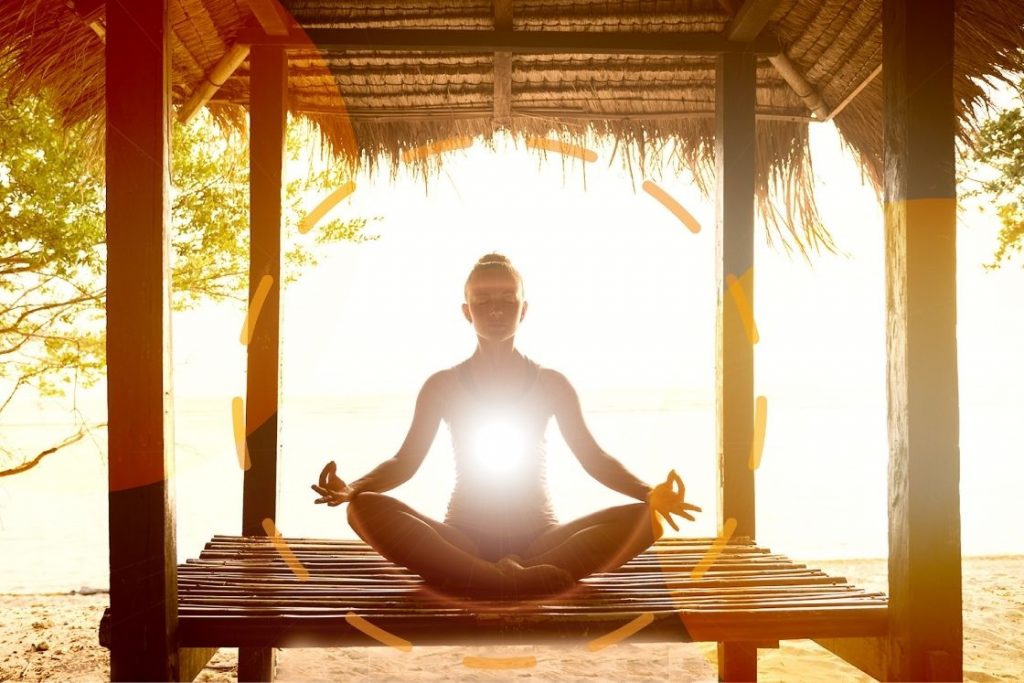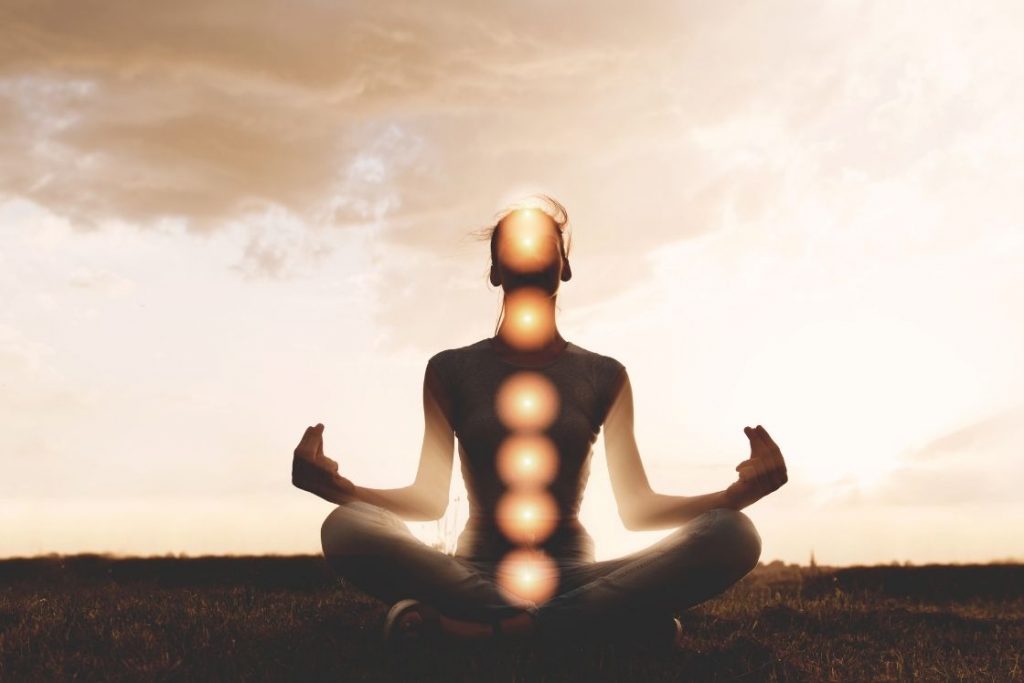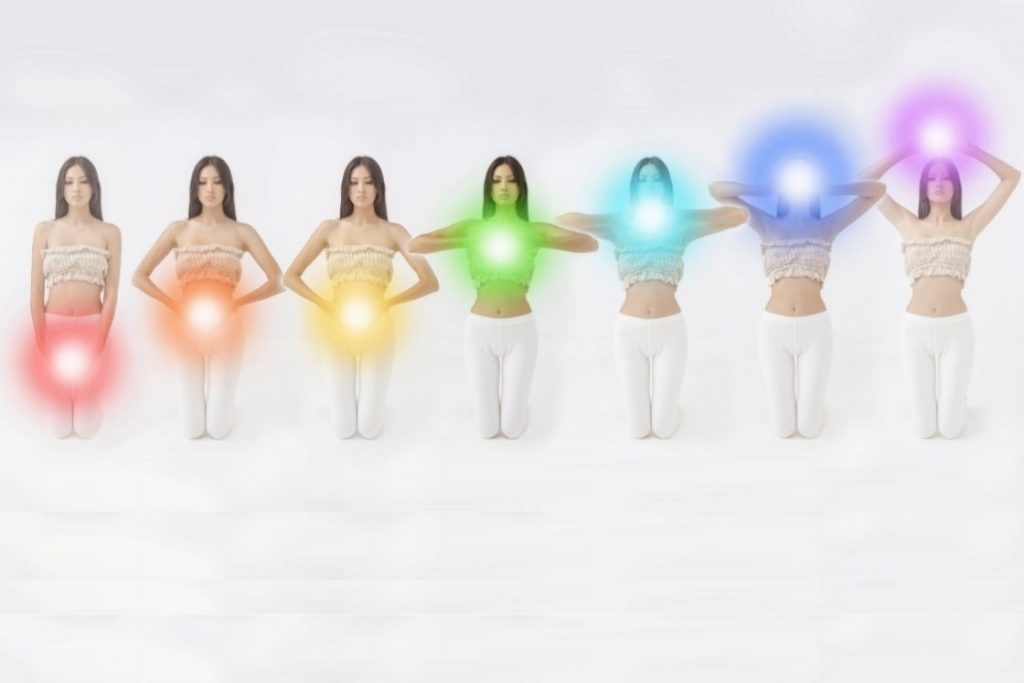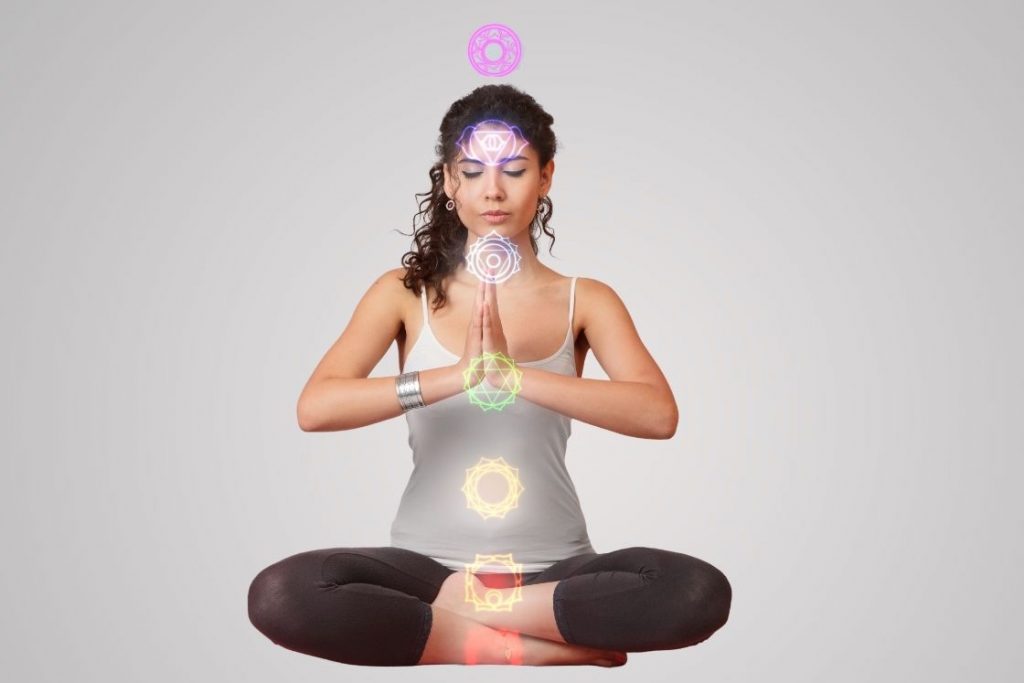
Chakra and Meditation are the two holistic subjects of mind-body healing practices developed in ancient India years ago. Most of us are usually aware of both these terms separately but when we combine them as ONE “Chakra Meditation”, what exactly it is?
Chakra Meditation is one of the various ways of balancing energy centres located along the spine. It comprises methods and exercises to focus the attention on blocked chakras and balance them to harness the power of these energy centres.
In chakra meditation, we focus on each chakra, generally starting from root to crown, to control and restore the energy that flows through them.
Let’s first start with understanding the 7 chakras in brief.
What are 7 chakras?
The name of each of these chakras signifies the point of their origination along the spine. They spin in a clockwise direction and vibrate at a specific frequency. If the chakra’s energy is blocked or it is not vibrating at its required frequency, it is said that the chakra is imbalanced.
Let us have a look at the chakras and their unique features individually along with the symptoms of balance and imbalance.
1. Root Chakra
- The root chakra is the 1st chakra and is located at the base of the spine.
- It is known as Muladhara in Sanskrit as it is represented by the color red and the element of earth.
- The bija mantra for this chakra is LAM.
- The root chakra is concerned with providing stability, security, vitality, and basic survival instincts.
- The kundalini energy also sits in the root chakra, which is the ultimate life-force energy.
- Insecurity, attachment issues, disillusionment, stagnation, lack of energy, anxiety, greed, mistrust, weight issues, bowel related problems are a few of the symptoms of imbalanced chakra.
- Living in the present, connected with the earth, stress-free mind, enhanced courage, self-esteem and integrity, excitement, motivation, increased personal growth are signs of a balanced root chakra.
2. Sacral Chakra
- In Sanskrit, it is known as Svadhisthana and is located just below the navel.
- It is associated with the element of water and is represented by the color orange.
- The bija mantra for this chakra is VAM.
- This chakra is the seat of creativity, feelings, sexuality, sensuality, passion, and enjoyment.
- Eating disorders, low self-esteem, addictions, no sex drive, dependency issues, lack of creative inspiration, bladder issues, and emotional instability are some of the symptoms of an imbalanced sacral chakra.
- A balanced chakra will make you feel passionate, friendly, joyful, increased self-worth, fulfillment, and nurtured.
3. Solar Plexus Chakra
- The 3rd chakra is known as Manipura in Sanskrit and is located at the navel or the area between the sacral chakra and the ribcage.
- It is associated with the element of fire and is represented by yellow.
- The bija mantra for this chakra is RAM.
- The chakra is concerned with transformation, personal power, independence, responsibility, and confidence.
- When imbalanced, it shows symptoms of perfectionism, low self-image, mistrust in your gut, issues with control, irresponsibility, lack of motivation, etc.
- In a balanced state, you will have clear intentions, make decisions easily, trust your intuition, provide strength to overcome challenges, and will feel confident to achieve your goals.
4. Heart Chakra
- It is called Anahata in Sanskrit and is represented by the color green.
- The chakra is located at the center of the chest, just where the heart resides.
- The bija mantra for this chakra is YAM.
- The element of air is associated with the heart chakra and is the seat of unconditional love, compassion, forgiveness, gratitude, acceptance, and connection.
- Manipulation, codependency, mistrust, jealousy, lack of empathy, antisocialism, isolation, lack of self-worth, toxicity in relationships are signs of an imbalanced heart chakra.
- Seeing the beauty of the world, connection with self, compassion, empathy, generosity, self-acceptance, ability to give and receive affection are signs of a healthy and balanced chakra.
5. Throat Chakra
- This chakra is called Vishuddha in Sanskrit and is located at the throat and the area around it.
- It has the element of space and the color is blue.
- The bija mantra for this chakra is HAM.
- The throat chakra is concerned with creativity, self-expression, communication, truth, and trust.
- You will suffer from being secretive, shyness, insecurity, social anxiety, low self-esteem, verbal aggression, fear of public speaking, arrogance if your chakra is imbalanced.
- A balanced throat chakra will make it easy for you to communicate, speak in front of a large crowd, clear expression of thoughts, and be emotionally balanced.
6. Third Eye Chakra
- This is the 2nd last chakra and is located between the eyebrows.
- Called Ajna in Sanskrit, it is represented by the color indigo or royal blue and the element of light.
- The bija mantra for the chakra is OM.
- The chakra’s main function is to provide intuition, wisdom, intellect, vision, clairvoyance, awakening, and inspiration.
- You will feel insignificant, closed-minded, indecisive, paranoia, unable to see the big picture, have fear of criticism, and fear of change in case of an imbalance of chakra.
- You will understand the unity of the world, engage in mindfulness and self-reflection, understand the deeper meaning of life, and find it easier to embrace a new beginning with a balanced third eye chakra.
7. Crown Chakra
- The last chakra is located on top of our head which is also known as the crown.
- In Sanskrit, it is called Sahasrara and is associated with the color violet or white.
- The bija mantra for this chakra is silent OM or AH.
- The Crown chakra is the seat of enlightenment, spiritual connection, universal awareness, and consciousness.
- You will be greedy, depressed, disconnected from the higher self, judgemental, lonely, selfish, entitled, and play the victim when your crown chakra is imbalanced.
- Feeling connected with the divine, non-judgemental, selflessness, increased spiritual insight, the experience of true joy and happiness are signs of balanced chakra.
What is Chakra Meditation?

You have already read the symptoms of chakra imbalances and it doesn’t paint a pretty picture of life. Just like there is a medicine for most of the problems occurring in our body, similarly, chakra meditation works as a medicine for healing these energy centres of the body.
Chakra meditation is an umbrella term for all those practices through which we target to open a blocked chakra or heal its imbalance symptoms.
Just like any other meditation, chakra meditation helps us achieve a mentally clear and emotionally calm and stable state. There are various types of chakra meditation that you can choose to meditate such as color visualization, mudra meditation, mantra meditation, or meditation for a particular chakra.
Based on the concern you want to address, you can pick a chakra meditation form. For example, if you have decided on practising a root chakra meditation, you will be focusing on balancing the stability, security, responsibility aspects. For that, you can practice yoga asanas that focus on the legs and pelvic region along with mindfulness meditation.
Hence, you must decide your target points before you start performing a chakra meditation.
Benefits of Chakra Meditation
- You not only gain a sense of peace and contentment, but it also instills the love for life.
- A calm mind will aid in reducing anxiety, stress, and negative thought patterns.
- It will aid in building your strength and willpower from within, which gives you a positive attitude.
- With increased willpower, you will have the confidence and strength to achieve your goals.
- It will become easier to see the positive side for any negative thought or situation.
- Your mind and body are in tune with each other and this improves your attitude and temperament.
- Chakra meditation will help you heal yourself when you face any emotional pain.
- Self-acceptance and self-worth will increase.
- Mental clarity will pave a way for enhanced intuitive abilities.
How to Meditate for Chakra Balancing?

When we think of meditation, we only think of sitting cross-legged on the ground and breathing deeply for a few minutes. However, there are different techniques in chakra meditation through which you can heal your chakras.
While there is no doubt that you will be sitting cross-legged on the ground or a cushion and keeping your hands in a specific mudra, the way you meditate to target the problem points are varied.
1. Start breathing gently with chakra color visualization
One of the most common ways of chakra meditation is visualizing the color of the chakra spinning like a wheel. As you keep breathing, you imagine the size of the orb growing and then you take in its warm healing energy, and any thoughts that arise are not dwelled upon. This is often called mindfulness meditation. For more assistance, you can even place your hands on the focal points of the chakra to increase your focus and concentration.
Many practitioners also recommend wearing chakra color clothes when you are practising an individual chakra meditation. This technique is called color visualization; it’s based on the fact that each chakra has an association with a color of the visible spectrum. This is usually done for an enhanced healing effect.
2. Focus on chakra points
Talking about focal points, you can also engage the Mula Bandha to stimulate the lower chakras. This technique is most effective for the root chakra as the Mula bandha comprises engaging the pelvic floor muscles (nearest to root chakra location). You engage the Mula bandha by drawing up your pelvic floor and holding the position for a few seconds.
Moreover, you can also perform meditation while keeping your eyes open. Trataka or candle gazing meditation is just the method you are looking for if you want to open your third eye chakra for spiritual awakening. You keep the candle at a distance so that it levels with your eyes and you also get to keep your head straight. In this type of meditation, you keep your gaze on the flame and close your eyes when you are ending the practice.
3. Use crystals and music to meditate on a particular chakra
Similarly, you can also do crystal meditation for a particular chakra. For this, you hold chakra stones of a particular chakra either on your hands (in a sitting position) or place a crystal on the chakra that aligns with your intention (in prone position).
If you feel that listening to music makes you relaxed, turn on some chakra healing music to complement your meditation session. These sounds have special vibrational frequencies that resonate with the frequency of the chakras and aid in healing them faster. Similarly, you can also chant the bija mantra of the chakra during your meditation.
And to remain more focused in the duration of meditation, you can take the help of guided meditation which will help you visualize and move through the meditation easily.
Meditation for 7 Chakras

Now that you know the techniques that can help you with the chakra healing process, let us describe some general chakra meditation steps for each chakra that you can practice. Chanting the bija mantra, guided meditation, and color visualization can be done for all the chakras.
1. Root Chakra Meditation
Practice the mindfulness meditation technique while staying rooted to the ground. The root chakra is related to stability and staying grounded to the earth, hence, quite often, it is recommended that meditation for this chakra should be performed outside. This will help you in staying rooted to the ground and take in the energy of the mother earth.
You can either sit directly on the ground, or on a chair with your feet firmly planted to the floor. Keep your hands on your knees and sit in an upright position. Start by concentrating on your breathing pattern and getting your mind and body relaxed. Slowly close your eyes and bring your focus to the location of the root chakra.
Imagine a glowing red light spinning clockwise. As you keep breathing deeply, the light keeps growing, slowly engulfing the pelvic area. When you inhale, imagine this light radiating to the entire lower region of your body and with the exhale push any toxic energy or emotions to the earth.
You can also engage your Mula bandha when you are inhaling and exhaling.
2. Sacral Chakra Meditation
For the second chakra, you can try the visualization technique again. Additionally, you can use the sound of ocean waves, as the sacral chakra is associated with the element of water.
When you get relaxed in your meditative position, close your eyes and visualize an orange orb on the sacral chakra location. You can imagine your breath as a personification of the ocean waves. When you inhale, imagine the waves touching the shores and as you exhale, let those waves take away any blockages or imbalance with them. While imagining these waves, you can chant the bija mantra of this chakra, to resonate with the energy of the chakra.
Keep a healing chakra crystal such as carnelian in your hands to enhance the healing process.
3. Solar Plexus Chakra Meditation
This chakra is located in the abdomen hence stimulating the focal points by rubbing clockwise on your belly will help ignite the healing fire. To support this fire, practice Ujjayi breathing, which is one of the common forms of pranayam.
Sit in a comfortable upright position, and get your body relaxed. Massage your belly clockwise 10 times, which will soften your belly and also support your digestive system. Bring your hands to your thighs and take deep breaths. These deep breaths should make your belly full and support your ujjayi pranayama.
This technique will ignite heat within your body and it will burn all the negative and toxic thoughts. Imagine a fire burning behind your navel that will burn every blockage into ashes. This will aid in increasing our confidence and strength. Moreover, if you practice this technique during sunrise, it will be a wonderful addition to your meditation session.
4. Heart Chakra Meditation
The visualization technique works best for this chakra. Imagine the green emerald light filling your chest and strengthening the shield of protection. Now focus on the center of the chest, the heart chakra location, and visualize a pink diamond with a soft glow. It’s the love that you have in yourself that you are ready to share with the world. This is your spiritual heart that doesn’t need any additional light to be shone upon it.
You can also picture the faces of people whom you love and with whom you have issues, sending them this healing light of love.
5. Throat Chakra Meditation
The throat is an essential organ that helps you express your feelings and thoughts. The throat chakra is the seat of self-expression and chanting the bija mantra would be beneficial to stimulate this location. The vibrations will help in activating and healing the throat chakra. Singing and humming will also aid in your meditation.
When you are sitting for meditation, make sure your neck and jaw are relaxed. Move your head around to remove any stiffness. The skin around your lips should also be relaxed. Follow the color visualization technique here as well and make sure to use the warmth of the green light to stimulates your ears. They are also an essential part of your self-expression as you use them to hear from others and hear your inner voice.
6. Third Eye Chakra Meditation
To activate, balance or heal third eye chakra, candle gazing or trataka and mindfulness meditation work best. While in trataka, you keep your eyes open to gaze at the flame, in mindfulness meditation, you will close your eyes and go deep into your conscience. Though these two are different techniques, they both help in powerfully stimulating the third eye chakra.
For the trataka, sit comfortably and keep the candle at a distance where you look at the flame without bending or tilting up your head. When you gaze at the flame, your body should be still along with your eyes. If you feel like blinking, close your eyes gently and imagine the burn of the flame behind the eyelids. Open your eyes when the image has disappeared and resume the procedure.
In mindfulness meditation, you are trying to let go of your thoughts without judging or reacting to them. With your eyes closed, imagine indigo or blue light between the brows, you allow your thoughts to come forward and let them pass like clouds.
7. Crown Chakra Meditation
The crown chakra is the topmost chakra that is directly connected to the higher realms and Divine. Hence, a guided meditation will be helpful as it will carefully guide you to use the light to not only enhance the energies of all the chakras but also help in connection to your inner guides.
Most guided meditations are visualization meditations. For the crown chakra, you will visualize a blooming thousand petal lotus emitting a purple beam of light at the top of your head or the crown. This light will extend from the lotus center to the sky, connecting you to the light of the universe.
Now imagine you are extending the stem of this lotus all the way to the root chakra. With every inhale, the light draws in and with the exhale you are letting the light out towards the sky. This method will strengthen your centerline, also called Sushumna in yoga terms. You are also absorbing the Divine light and letting it back to the source.
Offering gratitude to the divine light at the end of the meditation will be of great help in rising to the spiritual sphere.
Conclusion
Chakra meditations are one of the best ways to activate, balance and heal your chakra. You are ensuring that the flow of energy throughout the body is at its best. Work through the techniques to see which one is best for you. You can also take the liberty to switch the chakra meditation techniques as per your intentions or the issues you want to address.
There is no set rule in meditation, however, through chakra meditation, you are building a solid foundation for your physical, mental and spiritual well-being.




